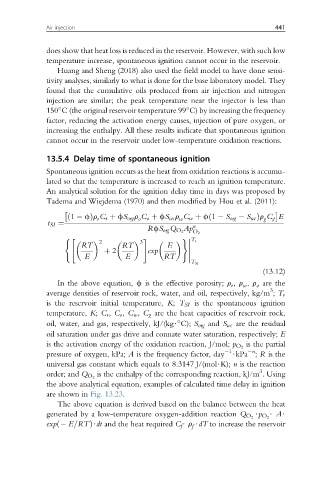Page 477 - Enhanced Oil Recovery in Shale and Tight Reservoirs
P. 477
Air injection 441
does show that heat loss is reduced in the reservoir. However, with such low
temperature increase, spontaneous ignition cannot occur in the reservoir.
Huang and Sheng (2018) also used the field model to have done sensi-
tivity analyses, similarly to what is done for the base laboratory model. They
found that the cumulative oils produced from air injection and nitrogen
injection are similar; the peak temperature near the injector is less than
150 C (the original reservoir temperature 99 C) by increasing the frequency
factor, reducing the activation energy causes, injection of pure oxygen, or
increasing the enthalpy. All these results indicate that spontaneous ignition
cannot occur in the reservoir under low-temperature oxidation reactions.
13.5.4 Delay time of spontaneous ignition
Spontaneous ignition occurs as the heat from oxidation reactions is accumu-
lated so that the temperature is increased to reach an ignition temperature.
An analytical solution for the ignition delay time in days was proposed by
Tadema and Wiejdema (1970) and then modified by Hou et al. (2011):
ð1 fÞr C r þ fS org r C o þ fS wc r C w þ fð1 S org S wc Þr C g E
o
r
g
w
t SI ¼ n
Ap
RfS org Q O 2
O 2
(" # )
2 3 T r
RT RT E
þ 2 exp
E E RT
T SI
(13.12)
In the above equation, f is the effective porosity; r , r , r are the
o
w
r
3
average densities of reservoir rock, water, and oil, respectively, kg/m ; T r
is the reservoir initial temperature, K; T SI is the spontaneous ignition
temperature, K; C r , C o , C w , C g are the heat capacities of reservoir rock,
oil, water, and gas, respectively, kJ/(kg$ C); S org and S wc are the residual
oil saturation under gas drive and connate water saturation, respectively; E
is the partial
is the activation energy of the oxidation reaction, J/mol; p O 2
n
1
pressure of oxygen, kPa; A is the frequency factor, day $kPa ; R is the
universal gas constant which equals to 8.3147 J/(mol$K); n is the reaction
3
is the enthalpy of the corresponding reaction, kJ/m . Using
order; and Q O 2
the above analytical equation, examples of calculated time delay in ignition
are shown in Fig. 13.23.
The above equation is derived based on the balance between the heat
generated by a low-temperature oxygen-addition reaction Q O 2 $p O 2 $ A$
expð E=RTÞ$dt and the heat required C f $ r $dT to increase the reservoir
f

